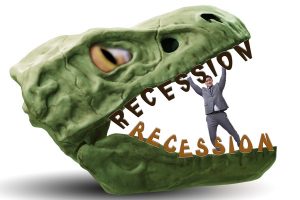CNBC
Federal Reserve Chairman Jerome Powell’s assertion this week that the U.S. economy remains strong is facing a stern test from the bond market.
In fact, government fixed income yields are delivering, by one measure, a possible recession indication that hasn’t happened since 2007
The spread, or yield curve, between the three-month and 10-year Treasury notes just broke the longest streak ever of being above 10 basis points, or 0.1 percentage points. The two maturities were last below that level in September 2007, a run of 3,009 trading days, according to Bespoke Investment Group. In Thursday afternoon trading, the spread was just 5 basis points, or as close to inversion as just before the financial crisis.
Economists see the yield compression as a dark signal for an economy coming off its best year since the recovery began in mid-2009.
“Yield curves are responding to what they see, to what I believe is a global economic slowdown,” said Peter Boockvar, chief investment officer at the Bleakley Advisory Group. “You don’t see this kind of move in curves, not just here but everywhere, unless you get one.”
Short-term yields moving ahead of their longer-duration counterparts is seen as a sign that growth will be higher now than it will be in the future. New York Fed research considered by many to be seminal on the spread between yields found that the most telling relationship was between the three-month and 10-year notes.
The Federal Open Market Committee, which sets monetary policy for the Fed, said Wednesday that it won’t be raising rates anytime soon — likely for at least the rest of the year — unless economic conditions change.
Powell said the U.S. economy is “in a good place” though it is facing pressure from slowdowns in Europe and China. He and his colleagues collectively lowered their expectations for GDP growth domestically, now seeing just a 2.1 percent gain in GDP for all of 2019 and 1.9 percent in 2020.
Bond market warning
Bond market investors are showing they think growth could be a good deal beneath even those tepid levels. Financial markets always factor into Fed decisions, so the yield picture likely played a role in the FOMC forecast that no further rate hikes will be coming this year, even though members indicated that two were likely as recently as December 2018.
“All anyone needs to do is read the first paragraph of the Fed press statement to see that the central bank has marked down its assessment of the economic landscape – the choice of words suggests far more than the tweaking that was done to the numerical projections,” David Rosenberg, chief economist and strategist at Gluskin Sheff, said in his daily note Thursday.
Like other financial market observers, Rosenberg noted the diverse reactions between the bond and stock markets — fixed income yields are falling, indicating lower growth, while the stock market is rising.
“The stock market may not agree with the recessionary message from the Treasury market, but it would be foolish to disregard this bond curve move entirely,” he wrote. “The real yield [compared to inflation] on a 10-year note has collapsed to a 14-month low of 0.56% — it never got his low during any part of the 2008/09 Great Recession, for some perspective.”

There’s some indication in the market that the Fed’s move yesterday to telegraph a decidedly dovish stance could help widen the spread somewhat.
However, the challenges for the economy remain.
“It will come down to the U.S. consumer. That’s the last thing that’s holding us up,” Boockvar said. “We’ll need a decline in the stock market to tip over the consumer. So if the stock market can hang in, I think the U.S. can continue to see some growth. If we start to go back to the December lows again, that could be enough to tip us over.”
